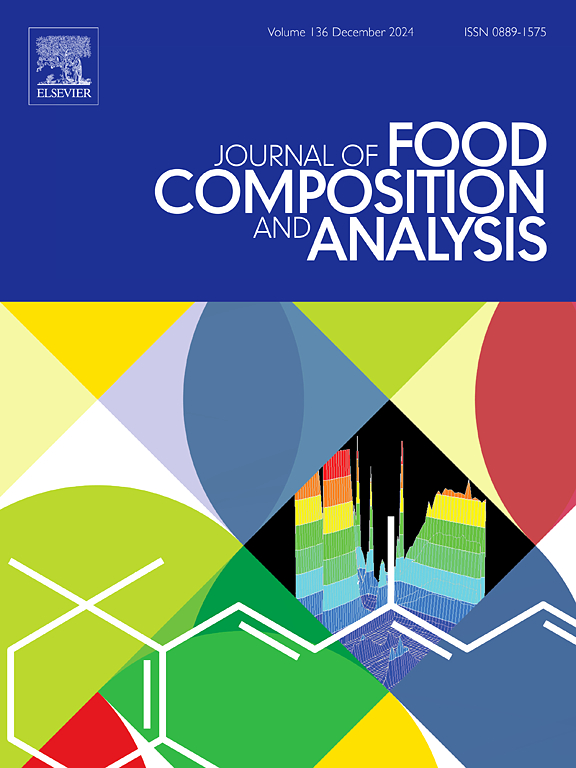气相色谱-质谱法鉴定牛油果籽粒半挥发性特殊代谢物
IF 4.6
2区 农林科学
Q2 CHEMISTRY, APPLIED
引用次数: 0
摘要
来自非洲野生树牛油果(Vitellaria paradoxa)的坚果是化妆品和食品中使用的植物黄油的宝贵来源,例如作为可可脂的等等物。除了甘油脂,玉米粒还含有三萜酯、植物甾醇和生育酚等具有生物活性的物质,如抗氧化、抗炎、抗癌和降低胆固醇的作用。在这里,GC-MS被用于分析三萜醇、乙酸酯、肉桂酸酯和相关代谢物。鉴定依赖于与标准品、保留时间、光谱库和文献的比较。通过皂化,鉴定出10种三萜醇,而未皂化提取物中鉴定出18种三萜酯、spinasterol和22,23-二氢spinasterol。三萜酯由三萜醇:amyrin (α、β和δ)、lupeol、butyrospermol、taraxasterol、Ψ-taraxasterol、羊毛甾醇、parkeol和24-亚甲基环醇衍生而来。丰富的是α-杏仁素和肉桂醇酯(共15.4 mg/g), α-醋酸amyrin(2.8 mg/g),肉桂酸丁酮醇(2.8 mg/g)和醋酸酯(1.6 mg/g),肉桂醇酯(2.2 mg/g), β-肉桂酸amyrin(1.6 mg/g)和醋酸酯(0.7 mg/g),三萜酯含量高达3.6 %乳木果仁。本研究首次以气相色谱-质谱法测定了乳木果仁中乙酸三萜酯和肉桂酸酯的绝对含量。该方法增加了对乳木果的特殊代谢物的认识,可以增强对其生物活性潜力的理解。本文章由计算机程序翻译,如有差异,请以英文原文为准。
Identification of semi-volatile specialized metabolites from Vitellaria paradoxa (shea) kernels using GC-MS
Nuts from the African wild tree Vitellaria paradoxa (shea) represent a valuable source of plant-based butter used in cosmetics and foods, e.g. as a cocoa butter equivalent. Beyond glyceridic lipids, kernels contain triterpene esters, phytosterols, and tocopherols with bioactive properties such as antioxidative, anti-inflammatory, anticancer, and cholesterol-lowering effects. Here, GC-MS was used to profile triterpene alcohols, acetates, cinnamates, and related metabolites. Identification relied on comparisons with standards, retention time and spectral libraries, and literature. Through saponification, the presence of ten triterpene alcohols was confirmed, while 18 triterpene esters, spinasterol and 22,23-dihydrospinasterol were identified in unsaponified extracts. The triterpene esters are derived from the triterpene alcohols amyrin (α, β and δ), lupeol, butyrospermol, taraxasterol, Ψ-taraxasterol, lanosterol, parkeol, and 24-methylenecycloartanol. Abundant ones are α-amyrin- and lupeol cinnamate (together 15.4 mg/g), α-amyrin acetate (2.8 mg/g), butyrospermol cinnamate (2.8 mg/g) and acetate (1.6 mg/g), lupeol acetate (2.2 mg/g), β-amyrin cinnamate (1.6 mg/g) and acetate (0.7 mg/g), with triterpene esters comprising up to 3.6 % of the shea kernels. This study provides the first GC-MS-based absolute quantities of triterpene acetates and cinnamates in shea kernels. The method adds to knowledge about shea’s specialized metabolites, which may enhance understanding of their bioactive potential.
求助全文
通过发布文献求助,成功后即可免费获取论文全文。
去求助
来源期刊

Journal of Food Composition and Analysis
工程技术-食品科技
CiteScore
6.20
自引率
11.60%
发文量
601
审稿时长
53 days
期刊介绍:
The Journal of Food Composition and Analysis publishes manuscripts on scientific aspects of data on the chemical composition of human foods, with particular emphasis on actual data on composition of foods; analytical methods; studies on the manipulation, storage, distribution and use of food composition data; and studies on the statistics, use and distribution of such data and data systems. The Journal''s basis is nutrient composition, with increasing emphasis on bioactive non-nutrient and anti-nutrient components. Papers must provide sufficient description of the food samples, analytical methods, quality control procedures and statistical treatments of the data to permit the end users of the food composition data to evaluate the appropriateness of such data in their projects.
The Journal does not publish papers on: microbiological compounds; sensory quality; aromatics/volatiles in food and wine; essential oils; organoleptic characteristics of food; physical properties; or clinical papers and pharmacology-related papers.
 求助内容:
求助内容: 应助结果提醒方式:
应助结果提醒方式:


